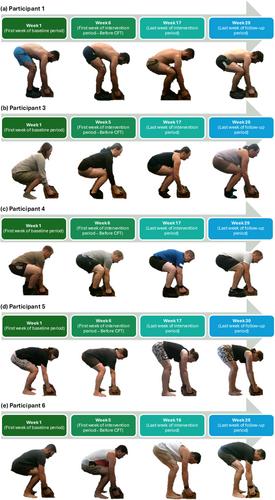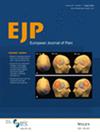Is Lifting Technique Related to Pain and Functional Limitation? A Replicated Single-Case Design Study of Five People With Lifting-Related Chronic Low Back Pain
Abstract
Background
Chronic low back pain (CLBP) is often provoked by lifting activities, but the relationship between changes in lifting technique and clinical outcomes while undergoing intervention remains unclear. This study examined the within-person relationships between changes in lifting technique and changes in pain and functional limitation in people with lifting-related CLBP.
Methods
Five participants with lifting-related CLBP completed repeated measures of their lifting techniques, pain and functional limitation across baseline (4–6 weeks), intervention (12 weeks) and follow-up periods (3 months). Participants received up to 10 sessions of Cognitive Functional Therapy (CFT) during the intervention period. Wearable sensors measured the spinal and lower extremities' range of motion (ROM) and velocity during a repeated lift task. Pain and functional limitation were assessed via online questionnaires. Within-person relationships were estimated using cross-correlation analyses.
Results
All participants demonstrated changes in lifting technique throughout the study, though with varied timing and direction. Changes in lifting technique were frequently related to changes in functional limitation (18/25 relationships, 72%) and sometimes to changes in pain (13/25 relationships, 52%). When relationships were observed, reductions in pain and functional limitation were predominantly (27/31 relationships, 87%) associated with a transition along a continuum from squat-like towards semi-squat-like and stoop-like lifting techniques with faster lifting movements.
Conclusions
Within-person changes in lifting technique varied among individuals. Greater trunk ROM and velocity, lower knee ROM and velocity, and faster lifting movements often co-occurred with lower levels of pain and functional limitation. This reflects a transition along a continuum from squat-like towards semi-squat-like and stoop-like lifting techniques.
Significance Statement
Our study reveals that changes in lifting technique may relate to clinical improvements in people with lifting-related CLBP on an individual basis. Contrary to conventional clinical and ergonomic advice promoting ‘safe’ squat lifting techniques, our findings suggest that transition from squat-like towards semi-squat-like and stoop-like lifting techniques with faster lifting movements often corresponds with reductions in pain and functional limitation. These findings challenge pervasive recommendations for squat lifting and support an individualised multi-dimensional approach to managing people with lifting-related CLBP.


 求助内容:
求助内容: 应助结果提醒方式:
应助结果提醒方式:


